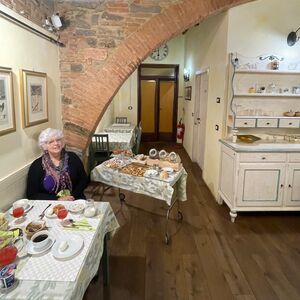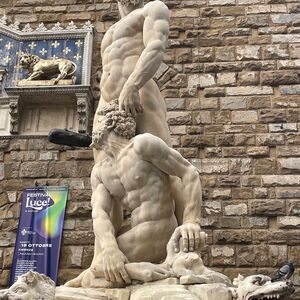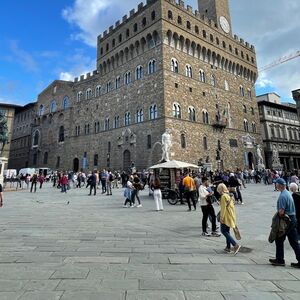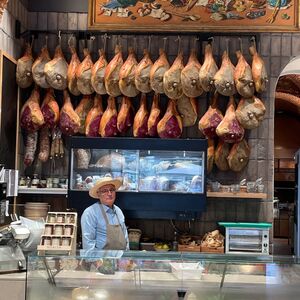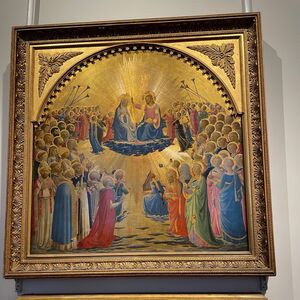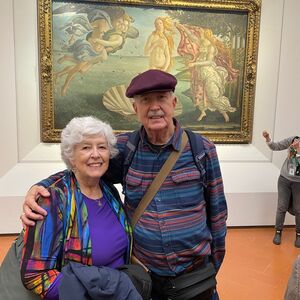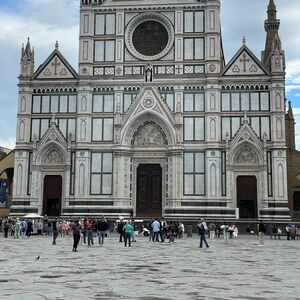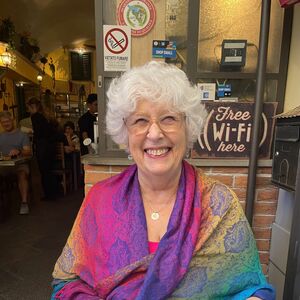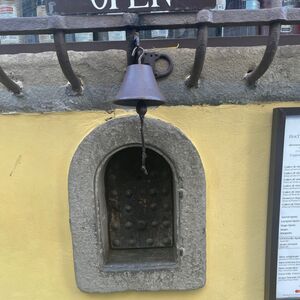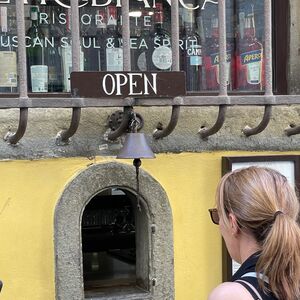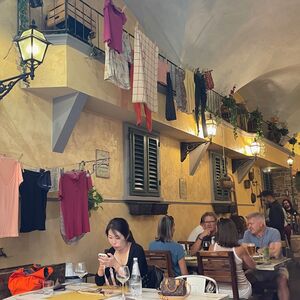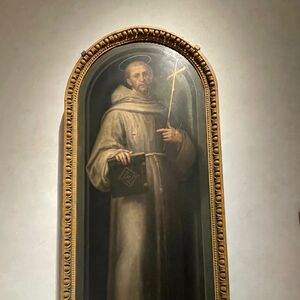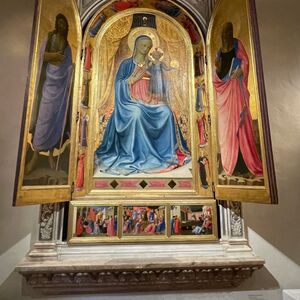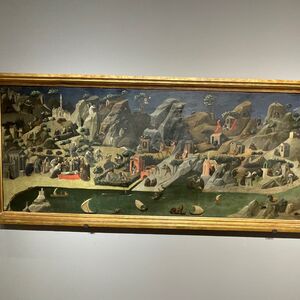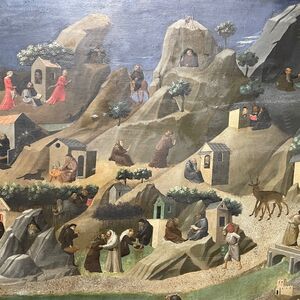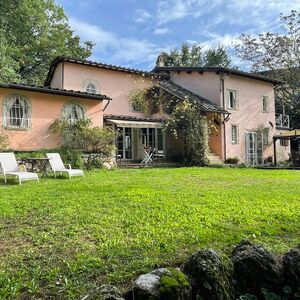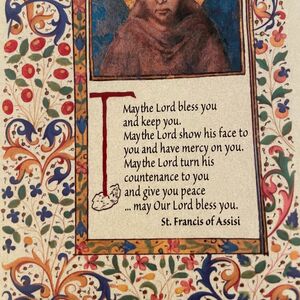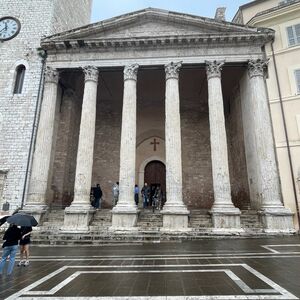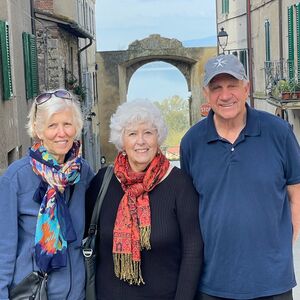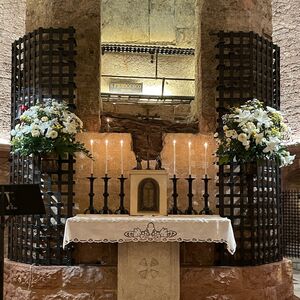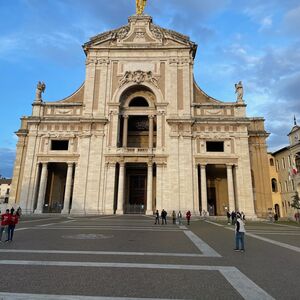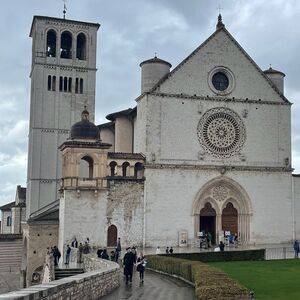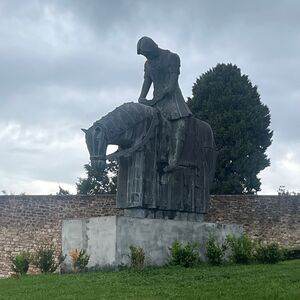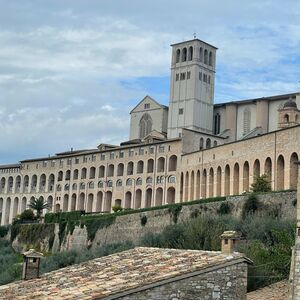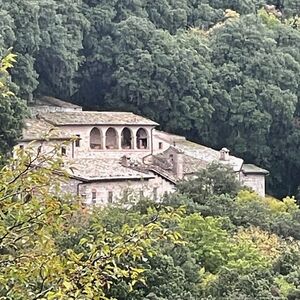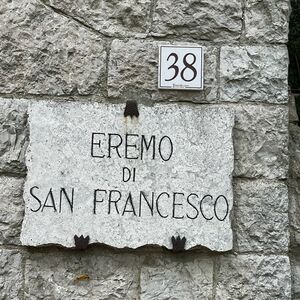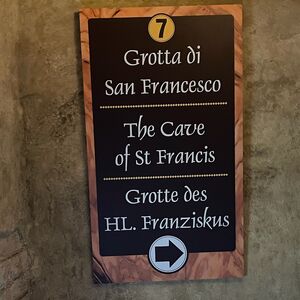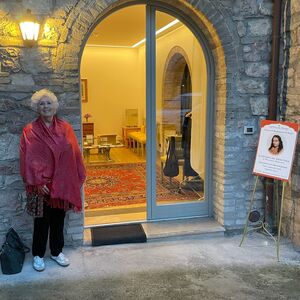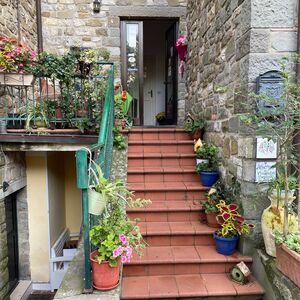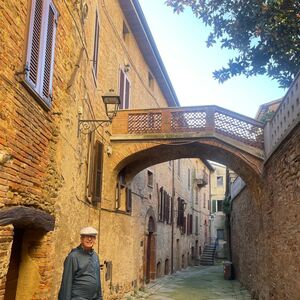
Kat & Bruce
Kat & Bruce
Honeymoon
Our Wonderful Honeymoon in Italy! See text boxes below for photo captions
Florence
We're back from our wonderful honeymoon in Italy! Thank you all for your love and generous support in getting us there!
We arrived in Florence on October 17 and spent 5 days there. We stayed at the B & B La Casa dei Tintori, an 800 year old building that was once a workshop for dyers of wool threads and cloth. It was located near the Arno River because of the unpleasant ingredients used to set the dyes. Later the building became a theater, and our beautiful and spacious Red Room was the main seating area. There was even still a balcony above. We didn't notice any ghostly theatergoers up there, fortunately. The hosts, Riccardo and Lavinia, were eager to be our guides to all things Florence. Their love and pride in the city was apparent and contagious.
We hope you'll take a look at the pictures from our trip.They are in 2 sections, one for Florence and one for Assisi. We will tell a bit about each one, moving from left to right and row to row. If you'd like a closer look, you can just click on the photo.
Photos of Florence:
Row 1: 1) Breakfast at the Casa Dei Tintori, our 800 year old home in Florence. It was once a dyer's workshop, near the river so the by-products of their trade could easily be carried away. Later the building became a theatre, and our room was the main hall, complete with a balcony. 2) Here we are by the Arno River, with the Ponte Veccchio in the background. 3) The River Arno. Row 2: 1) One of many glorious statues in the Piazza della Signoria, near the Palazzo Vecchio and the Uffizi Gallery. We had a lovely lunch on the Piazza, people-watching and admiring the statuary as we had cappucinos and pizza. 2) The Palazzo Veccchio, once a Medici palace and later the seat of the government of the Republic of Florence. 3) A rather amazing array of hams for sale at a butcher shop on the Piazza. 4) The Uffizi Gallery was filled with treasures, and these are some of our favorites. This is a ground-breaking painting of the Madonna and Child by Massacio. Row 3:
1) Our favorite paining, the Glorification of the Virgin by Fra Angelico. Fra Angelico was a Florentine monk who painted with great devotion. He was revered during his lifetime, and became "Blessed" (just one step away from becoming an official saint) after his death. We were inspired to see more of his work at the Museo of San Marco, which was the monastery where Fra Angelico lived and decorated the walls with his sublime paintings. 2) Us in front of Botticelli's sublime Birth of Venus. 3) The Bascilica of Santa Croce, which was our "neighborhood church", and the first Franciscan church in Florence, built to serve the poor tradespeople who lived close to the Arno River. It houses the tombs of Gallileo, Michaelangelo, and other famous Florentines, and is the first stop for pilgrims embarking on the Camino de San Francesco, leading them ultimately to Assisi. 4) The most iconic building in Florence, the famed Duomo. This was the largest dome built since antiquity, and was a wonder in its own time, bringing great fame and honor to its architect, Brunelleschi. It's still a glorious sight, especially by moonlight. We went out on a midnight walk and saw the Duomo like this, with the full moon close by the dome. It was a magical evening. Row 4: 1) Kat having a cappucino and a delicious lunch 2) A gelato shop that truly was a work of art. The cones were piled so high they looked like they would tip right over! Fun fact- gelato was invented in Florence as a treat for the Medici dukes and their friends. 3 and 4) A Wine Door. Ring the bell and someone appears to take your order and then passes you a glass of wine to be consumed on the spot, with the glass passed back through when finished.
Row 5: 1) We happened on an excellent restaurant with a celebrity chef and a reputation to match. The menu was unique and delicious, and the decor was certainly unique also-- featuring clotheslines with hanging laundry. 2) The former monastery and now museum of San Marco, where Fra Angelico lived and served the community of brothers with his art. Each monk's cell was decorated with a biblical painting by the saintly artist. Some of his best known works were painted on the walls of the refectory (dining room) and at the top of a stairway. 3) A painting of a monk. 4) A Virgin and Child by Fra Angelico. Row 6: 1 and 2) An interesting painting of monastic life in the Museo de San Marco. The closeup shows aspects of the monks' daily life, including their little cells and meditation caves.
Assisi and St. Francis
Photos of Assisi:
Row 1: 1) The Porto Nuovo, or new gate, the entrance to the walled city of Assisi we used most often. 2) Our home in Assisi, La Branchatta, an old farmhouse with lots of charm. Our apartment was on the left in the picture. It was wonderfully peaceful there, outside the city gates but only about a mile away in the countryside. Our neighbors were a convent of nuns who were harvesting their olive crop while we were there. They and their helpers were raking and shaking the trees, scattering the olives on tarps set out below. Later we were able to taste the fresh green olive oil from this year's harvest at a shop in the village. Bruce learned to make espresso in a moka pot during our stay, and treated us to strong coffee each morning. 3) A picture of St. Francis. This is said to be the most "true to life" image of him that still exists. The words on the card are the blessing that Francis used to give to his monks when they parted: May the Lord bless and keep you. May the Lord make his face to shine upon you and have mercy on you. May the Lord turn his countenance upon you and give you peace." Row 2: 1) Exterior of the church of Santa Maria Sopra Minerva in the city of Assisi, near the central piazza. This church was built around and over a Roman temple of Minerva, which in turn was built on top of an Etruscan temple. 2) The interior of Santa Maria Sopra Minerva. This church is unusual in that there is no crucifix, no image of the suffering Christ. Instead, the altar is topped by a triumphant statue of the Virgin Mary, crowned with a halo of stars (or electric lights, for the more prosaically inclined). 3) Our Assisi friends, companions, and guides. 4) The tomb of St. Francis, in the huge bascilica built to honor him. Row 3: 1) The Bascilica of Santa Maria degli Angeli, on a plain below the ancient walled city of Assisi. This massive and beautiful church was built around the tiny church that St. Francis and his monks built for themselves on land given to them by a Benedictine monastery. It was a tiny piece of land, called the Porzonicola, or little portion. This was the place where Francis received St. Clare when she ran away from her family to join him and founded the women's order of Poor Clares. It was also at this place that St. Francis passed away. Lying on his deathbed inside the chapel, he asked to be taken outside and laid upon the ground to give up his body there. The city of Los Angeles, our home, was named for this church by the Franciscan friars who established the California missions. 2) The front of the Bascilica of St. Francis. 3) A poignant statue of St. Francis in his early days, before he received his spiritual calling, returning on horseback from one of his two unsuccessful attempts to become a knight. It is placed on the large lawn facing the massive bascilica built to honor him. This bascilica is unusual in that it contains two complete churches, built on top of each other, and that it houses some of the most important works of the master artists Giotto and Cimabue. 4) Side view of the basilica of St. Francis, showing the large monastery attached to it. Row 5: 1) The Eramo, or Hermitage of St. Francis on Mount Subasio. This is the area where Francis and the monks retired from their traveling and preaching to reconnect with their spirits through silent prayer and meditation in the many caves that dot the mountainside. Now a monastery and visitors' center has been built there. 2 and 3) A sign and a plaque identifying the cave of St. Francis. 4) The altar that has been placed in the cave where Francis meditated. There is a little spot where a natural bench has formed in the rock wall at the back of the cave that makes a perfect meditation seat where on can quietly sit unnoticed by the passers by. Row 5: 1) The robes of St. Francis and St. Clare in the Bascilica of St. Clare, which sits on the opposite side of the walled city of Assisi from the Bascilica of St. Francis. 2) Kat at the meeting place of the SRF Meditation Circle in Assisi. 3) The sign outside the door of the Circolo. 4) The Assisi group. Row 5: 1) The Isola Maggiore, or Big Island, in the midst of Lake Trasimeno. We journeyed there by boat, to the place where St. Francis fasted one Lent, accompanied only by a rabbit that would not leave his side. We walked about on the island and saw two caves where he sheltered during that stormy Lenten season. 2) The fortified castle on the Isola Maggiore. 3) Steps leading to a home in a tiny hamlet overlooking Lake Trasimeno. 4) Bruce on a street of the ancient hamlet.
